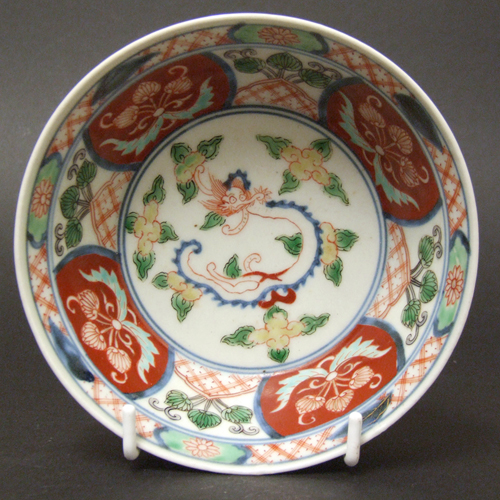
ARITA c.1700 – 1730 Japanese Porcelain
An 18th Century Kenjo-Imari Bowl, Arita Kilns c.1700-1730. Decorated using the Five Coloured Imari Palette of Iron Red, Green, Turquoise, Aubergine and Yellow, Black and Gilding. The Design is of Dragon with Four Aoi–Mons Set Against Crossed-hatched and Stylized Leaf Patterns. The Reverse is of Flowering Prunus. The Base has an Apocryphal Wanli Mark.
SOLD
- Condition
- Good, rubbing to the gilding.
- Size
- Diameter : 14.4 cm (5 3/4 inches) Height : 5.5 cm (2 1/4 inches)
- Provenance
- N/A
- Stock number
- 22447
Information
Japanese Imari Porcelain :
Imari Porcelain is the European collectors` name for a type of Japanese Porcelain made in the town of Arita, in the former Hizen Province, north western Kyūshū, and exported via the port of Imari, specifically for the European Export trade. Imari was simply the trans-shipment port for Arita wares, no porcelain was made there. The kilns at Arita formed the heart of the Japanese Porcelain industry, which developed in the early 17th century, after the white kaolin clay was discovered in 1616 by abducted Korean potter Yi Sam Pyeong (1579-1655). The decoration we know as imari started in about 1680 and is characterized by its vibrant colour scheme of underglaze cobalt blue and overglaze iron-red with gilding. Variations of this basic palette exist, for example Kenjo-Imari or `Presentation` imari, this type was especially popular in Japan during the first three decades of the 18th century. However, Imari ware was primarily made for export, most being destined for Europe. Numerous five-piece Imari garniatures were made for grand European houses, the largest were made to be displayed on the flour while others were made to be for display on furniture or the chimney. Other items made for grand displays were imari dishes, some of which could have a diameter of 60 cm but also useful wares were made, tea and coffee services, as well as virtually anything else you wanted made of porcelain, even miniatures for Dutch dolls houses. The iron red with gilding set off the cobalt blue, this colour scheme would sparkle in candle or day light adding much needed shimmering colour and richness to a Baroque European room setting. The decline in Japanese imari production in the second quarter of the 18th century did not mean the end of imari decoration, the Chinese copied Japanese imari wares as did the Europeans. Pieces from the large collection belonging to Augustus the Strong were copied by Meissen as early as c.1730. Although Imari originating in Japan the tern is used to describe a whole range of ceramics from all over the world, they are all linked by their palette of blue, red and gold.